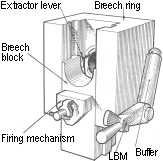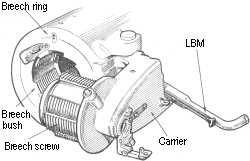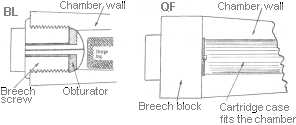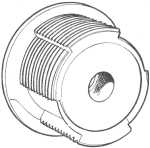|
Home History index
|
Breech Mechanisms |
|
Breech mechanisms close the breech end of the gun and are designed to withstand the huge rearward thrust of the propellant gas pressure when the gun fires. They carry the firing mechanism and, in BL guns, provide obturation, or in QF guns, support the cartridge case and allow it to be extracted after firing.
Breech mechanisms can be divided into two types: sliding block (for QF equipments), and breech screw (for QF or BL equipments). |

Sliding block mechanism |

Breech screw mechanism |
Sliding Block Mechanism
Sliding block mechanisms are made up seven main parts:
- Breech ring,
- Breech block,
- Gearing to open and close the breech,
- Breech block buffer,
- Extractors, to remove the empty cartridge,
- Devices to limit movement, and
- Safety devices, to prevent firing until the block and/or gearing is fully closed.
|
|
The breech ring is made up of two slotted jaws between which the block slides. The rings are either 'closed jaw' or 'open jaw' types. Closed jaw breech rings are stronger than open jaw rings but the firing mechanism is easier to access (though less well protected) in the open jaw ring.
The blocks slide either vertically or horizontally in the breech ring under the action of gearing. A horizontal sliding block (used in the M1A1 75-mm howitzer) requires less power to close than a vertical sliding block, and the closing effort remains constant at all angles of elevation - an advantage when using heavy sliding blocks particularly in semi-automatic situations. |

Sliding block type breech rings
L to R: Open jaw, Tied jaw, Closed jaw. |
The vertical sliding block (used in the 105-mm L5 howitzer and the 25-pr) aids in easy loading because the top face of the block can act as a loading tray, and the block cannot foul the trail if the breech is opened at high elevation as the horizontal sliding block can on box type trails or at full traverse with split trails.
The LBM (lever breech mechanism) opens the breech and operates the extractors. Gearing can be hand operated (in which the breech is opened and closed by hand), semi-automatic (in which loading and firing are carried out by hand and all other operations are automatic), or automatic. A breech block buffer system brings the block gradually to rest in the open position. When the block is finally arrested, the extractors are locked back against the block face, and the buffer forces the block up, releasing the heals of the extractors and allowing the next round to be loaded. A mechanical lock stops the block opening when the gun is fired.

Obturation methods
In QF systems, the charge is contained in a metal cartridge case which expands on firing and provides obturation (obturation is a function of the ammunition). In BL systems, the charge is contained in cloth bags and obturation is achieved by a resilient pad on the breech screw which seals the rear of the chamber (obturation is a function of the gun).
Breech Screw Mechanism
Breech screw mechanisms are made up of seven main parts:
|
- Breech ring, and possibly breech bush,
- Breech screw,
- Carrier,
- Attachment of the breech screw to the carrier,
- LBM and gearing to rotate the breech screw and swing the screw and carrier to the open and closed positions,
- Devices to limit movement, and
- Safety arrangements.
It may also carry the obturator. |

Welin breech screw.
Note the stepped segments and interrupted thread. |
The breech ring is circular and has a circular opening into which the breech screw fits. The opening may be fitted with a removeable breech bush.
Breech screws have interrupted threads which allow the screw to be locked or unlocked by a partial turn of the screw. Their strength depends on their length, diameter, and the percentage of the surface carrying screw threads, so the greater the percentage bearing surface the shorter the breech screw needs to be and the easier it is to open. Longer screws require axial withdrawal movement on opening. Gearing enables a single motion of the LBM to fully open the breech, by linking the unscrewing, withdrawing and swinging clear movements in one continuous action, and was incorporated into the Asbury mechanism (introduced in 1916). Stepping the circumference of the screw increases the bearing surface and reduces the turning movement needed. Welin breech screws have interrupted threads on stepped segments, with the threads cut at varying radii to increase the percentage bearing surface. In the figure above, one third of the bearing surface is not threaded, and the screw requires one sixth of a turn to open it. The Welin breech screw can be modified by adjusting the radii to allow it to start to swing clear before the opening rotation is complete.
A carrier is used to support the breech screw when it is clear of the gun, and to allow the breech screw to swing to and from the breech opening.
The Asbury mechanism allows a single motion of the LBM to turn and open the breech screw. It is characterised by five special features:
- LBM on the right, nearly vertical when closed, thus easily operated.
- Crank and crosshead gearing.
- Modified Welin breech screw.
- Cam rotating and roller. A concave cam forming nearly a quarter of a circle is attached to the rear face of the breech ring. On closing the breech, a roller mounted on the breech screw engages the cam and merges the swinging motion of the carrier into a rotation of teh breech screw, producing a single motion mechanism. Rebound of the screw is prevented by an extension of the roller spindle moving behind a projection on the cam as the screw rotates to the closed position. On opening the breech, the cam starts the swinging motion of the carrier and gives a positive unseating of the obturator if the rearward travel of the screw on unlocking has been inefficient.
- Control arc, mounted on the breech ring, prevents rotation of the breech screw when closing the breech by maintaining contact with either the LBM or the breech screw until the roller contacts the cam rotating.
Comparison
Generally, screw mechanisms are slower to operate than sliding block mechanisms, are less safe with a tendency for the loader's hand to be caught as the breech is closed, and are more complicated and slower to manufacture. They have the advantages of not requiring cartridge cases, and allowing a lighter breech mechanism because of the more equitable distribution of the rearward thrust on firing. The circular shape does not produce the large bending stresses of the sliding block, and, because the threads on the screw and breech ring can be cut on a lathe, close mating can be achieved so that the escape of combustion products out the breech on firing is reduced.
|
|
| Equipment | Breech Mechanism |
| Type | Gearing | Mechanical lock | Obturator | Other |
| 75-mm M1A1 | QF horizontal sliding block | Hand operated | Past dead centre | | Rolling fulcrum extractors |
| L5 105-mm | QF vertical sliding block | Hand operated | Strut type concentric path | | Fixed fulcrum extractors |
| 25-pr | QF vertical sliding block | Hand operated | Strut type flat on crank | | Fixed fulcrum extractors |
| SP 105-mm L13A1 | QF vertical sliding block | Semi-auto | Past dead centre | | Fixed fulcrum extractors shell retainer |
| 5.5-in | BL Single motion Asbury mechanism | Hand operated crank and crosshead | Past dead centre | Steep coned. Crossley pads | |
| 155-mm L8A1 | BL Single motion Asbury mechanism | Hand operated crank and crosshead with retracting gear | Past dead centre |
Slow coned. Bonded rubber or oil bonded pads. | Loading tray clips into breech and forms shell retainer |
| 175-mm M107, M113 | BL Single motion Asbury mechanism | Hand operated crank and crosshead | Past dead centre | Steep coned. Oil bonded. Wire covered | |
| 8-in M2 | BL Single motion Asbury mechanism | Hand operated crank and crosshead | Past dead centre | Steep coned. Crossley pads | |
|
|
References:
User handbooks - 25-pr, BL 5.5-inch, 105-mm
Artillery Training Volume III Pamphlet 1
Course notes (various), School of Artillery, Waiouru.
Return to top
|
More equipments
|
Home
|